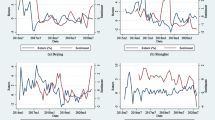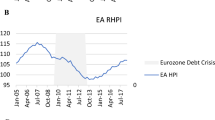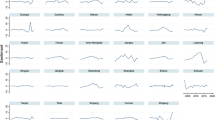Abstract
This paper reports a series of empirical tests that scrutinised the potential effect of market sentiment on China’s housing prices at the city level. The analyses employed unbalanced panel data from 45 large- and medium-sized cities in China for the period of 2011 to 2017. We first constructed the housing market sentiment index using principal component analysis, following which the index was applied in a system GMM estimation to analyse its impact. The results of the dynamic GMM estimation indicated that market sentiment plays a significant role in increasing housing prices in the 45 selected cities. Subsequently, general fixed effect regressions, placebo tests, and Poisson regressions were performed to test the robustness of the dynamic GMM estimation results. All the robustness checks confirmed the positive impact of market sentiment on housing prices. Additionally, we investigated the moderating effects of mobile network coverage, wage rate, and education on the positive relationship between market sentiment and housing prices. It was revealed that mobile network coverage has a positive moderating effect on this link, while wage rate and education have negative moderating effects. Lastly, this study explored the heterogeneity of market sentiment’s effect on housing prices, concluding that although this effect is positive in both first- and second-tier cities, it is significantly stronger in first-tier cities. The research findings are useful for the Chinese government in regulating housing prices by stabilising market sentiment.




Similar content being viewed by others
Availability of data and materials
Available upon request.
Code availability
Available upon request.
Notes
“Riguangpan” is a vivid description of a scene in which all houses for sale are sold out on the opening day, marking the boom of China’s housing market.
The Baidu search engine generates about 5,650,000 results for the search term "riguangpan" and 4,720,000 results for the search term "panic-buying houses".
Data on annual housing turnover in China was obtained from the CEInet Statistics Database. The annual growth rate was calculated by the authors.
The average growth rate of housing prices in the Chinese mainland's 31 provincial regions from 1999 to 2018 was 463%, while Shanghai’s alone was 686%. Although the growth rate in Shanghai is higher than the average in China, it is not the highest. Jiangxi (730%) and Shaanxi (694%) both reached higher rates than Shanghai. The data on provincial housing prices was derived from the CEInet Statistics Database, while the growth rates of housing prices were calculated by the authors.
MNC is expressed by the number of mobile phone users. Edu is expressed by the number of college students per 10 thousand people.
Housing supply is expressed by floor space of completed housing. Housing demand is expressed by commercial housing sales by floor area.
The list of the first- and second-tier cities is presented in Table 11 of the Appendix.
For example, \(rlNHS_{it}\) and \(rlNHS_{i,t - 1}\) form a group, and so on.
The website address is http://index.baidu.com/v2/index.html#/.
The six indicators are NHS, SHS, NHFSC, LPV, RLTN and LPR.
Four second-tier cities were excluded from the analysis due to a lack of Baidu Index data.
For example,, \(rlNHS_{it}\) and \(rlNHS_{i,t - 1}\) form a group, and so on.
We should have presented 2017’s results; however, due to missing data on some cities in 2016 and 2017, we presented 2015’s results.
References
Arellano, M., & Bond, S. R. (1991). Some tests of specification for panel data: Monte Carlo evidence and an application to employment equations. Review of Economic Studies, 58(2), 277–297. https://doi.org/10.2307/2297968
Baker, M., & Wurgler, J. (2006). Investor sentiment and the cross-section of stock returns. The Journal of Finance, 61(4), 1645–1680. https://doi.org/10.1111/j.1540-6261.2006.00885.x
Benos, A. (1998). Aggressiveness and survival of overconfident traders. Journal of Financial Markets, 1(3), 353–383. https://doi.org/10.1016/S1386-4181(97)00010-4
Chen, H., Chong, T. T., & Duan, X. (2010). A principal-component approach to measuring investor sentiment. Quantitative Finance, 10(4), 339–347. https://doi.org/10.1080/14697680903193389
Chiu, R. L. (1996). Housing affordability in Shenzhen special economic zone: A forerunner of China’s housing reform. Housing Studies, 11(4), 561–580. https://doi.org/10.1080/02673039608720875
Chong, T. T., Cao, B., & Wong, W. K. (2017). A principal component approach to measuring investor sentiment in Hong Kong. Journal of Management Sciences, 4(2), 237–247.
Clarke, R. G., & Statman, M. (1998). Bullish or bearish? Financial Analysts Journal, 54(3), 63–72.
Clayton, J., Ling, D. C., & Naranjo, A. (2009). Commercial real estate valuation: Fundamentals versus investor sentiment. The Journal of Real Estate Finance and Economics, 38, 5–37. https://doi.org/10.1007/s11146-008-9130-6
CNNIC. (2021). The 47th China statistical report on internet development. Retrieved February 4 2021 from http://www.cac.gov.cn/2021-02/03/c_1613923423079314.htm (in Chinese).
Cornaggia, J., & Li, J. Y. (2019). The value of access to finance: Evidence from M&As. Journal of Financial Economics, 131(1), 232–250. https://doi.org/10.1016/j.jfineco.2018.09.003
Da, Z., Engelberg, J., & Gao, P. (2015). The sum of all FEARS investor sentiment and asset prices. The Review of Financial Studies, 28(1), 1–32. https://doi.org/10.1093/rfs/hhu072
Davis, E. P., & Zhu, H. (2011). Bank lending and commercial property cycles: Some cross-country evidence. Journal of International Money and Finance, 30(1), 1–21. https://doi.org/10.1016/j.jimonfin.2010.06.005
Dong, Z., Hui, E. C., & Yi, D. (2021). Housing market sentiment and homeownership. Journal of Housing and the Built Environment, 36(1), 29–46. https://doi.org/10.1007/s10901-020-09784-y
Fang, J., Gozgor, G., Lau, C. K. M., & Lu, Z. (2020). The impact of Baidu Index sentiment on the volatility of China’s stock markets. Finance Research Letters, 32, 101099. https://doi.org/10.1016/j.frl.2019.01.011
Fischhoff, B., Slovic, P., & Lichtenstein, S. (1977). Knowing with certainty: The appropriateness of extreme confidence. Journal of Experimental Psychology: Human Perception and Performance, 3(4), 552–564. https://doi.org/10.1037/0096-1523.3.4.552
Fisher, K. L., & Statman, M. (2000). Investor sentiment and stock returns. Financial Analysts Journal, 56(2), 16–23. https://doi.org/10.2469/faj.v56.n2.2340
Frank, J. D. (1935). Some psychological determinants of the level of aspiration. The American Journal of Psychology, 47, 285–293. https://doi.org/10.2307/1415832
Groves, R. M. (2004). Survey errors and survey costs. Wiley.
Guo, W., & Wang, W. (2021). Financial agglomeration, regional housing prices and industrial structure upgrading: Two-wheel drive or two-way suppression? Journal of Capital University of Economics and Business, 23(1), 24–37. https://doi.org/10.13504/j.cnki.issn1008-2700.2021.01.003 (in Chinese).
Hamburger, W. (1955). The relation of consumption to wealth and the wage rate. Econometrica, 23(1), 1–17. https://doi.org/10.2307/1905577
Hui, E. C., Dong, Z., & Jia, S. (2018). How do housing price and sentiment affect consumption distribution in China. Habitat International, 77(7), 99–109. https://doi.org/10.1016/j.habitatint.2018.01.001
Hui, E. C., Dong, Z., Jia, S., & Lam, C. H. (2017). How does sentiment affect returns of urban housing? Habitat International, 64(6), 71–84. https://doi.org/10.1016/j.habitatint.2017.04.013
Hui, E. C., Wang, X., & Jia, S. (2016). Fertility rate, inter-generation wealth transfer and housing price in China: A theoretical and empirical study based on the overlapping generation model. Habitat International, 53, 369–378. https://doi.org/10.1016/j.habitatint.2015.12.010
Hui, E. C., & Wang, Z. (2014). Market sentiment in private housing market. Habitat International, 44, 375–385. https://doi.org/10.1016/j.habitatint.2014.08.001
Jiang, Y., & Zhu, X. (2021). The gap between the rich and the poor, the mismatch of financial resources and the fluctuation of property prices. Statistics & Decision, 37(12), 117–121. https://doi.org/10.13546/j.cnki.tjyjc.2021.12.026 (in Chinese).
Jin, C., Soydemir, G., & Tidwell, A. (2014). The US housing market and the pricing of risk: Fundamental analysis and market sentiment. Journal of Real Estate Research, 36(2), 187–220. https://doi.org/10.1080/10835547.2014.12091390
Jo, K. J., & Kim, S. B. (2014). Price inertia in the residential property market. International Journal on Information, 17(8), 3571–3576.
Jokar, H., & Daneshi, V. (2020). Investor sentiment, stock price, and audit quality. International Journal of Managerial and Financial Accounting, 12(1), 25–47. https://doi.org/10.1504/IJMFA.2020.107000
Kelly, R., McCann, F., & O’Toole, C. (2018). Credit conditions, macroprudential policy and house prices. Journal of Housing Economics, 41, 153–167. https://doi.org/10.1016/j.jhe.2018.05.005
Kim, J. H. (2005). Housing price hike and price stabilization policy in Korea. KDI School of Public Policy and Management.
Kim, H. B., Choi, S., Kim, B., & Pop-Eleches, C. (2018). The role of education interventions in improving economic rationality. Science, 362(6410), 83–86. https://doi.org/10.1126/science.aar6987
Kim, K., Ryu, D., & Yang, H. (2019). Investor sentiment, stock returns, and analyst recommendation changes: The KOSPI stock market. Investment Analysts Journal, 48(2), 89–101. https://doi.org/10.1080/10293523.2019.1614758
Kuang, W., Zhang, S., & Zhang, Z. (2020). Media sentiment and housing price volatility. Economic Theory and Business Management, 40(12), 56–68. (in Chinese).
Lai, R. N., & Order, R. A. V. (2010). Momentum and house price growth in the United States: Anatomy of a bubble. Real Estate Economics, 38(4), 753–773. https://doi.org/10.1111/j.1540-6229.2010.00282.x
Lam, C. H., & Hui, E. C. (2018). How does investor sentiment predict the future real estate returns of residential property in Hong Kong? Habitat International, 75(5), 1–11. https://doi.org/10.1016/j.habitatint.2018.02.009
Li, X., & He, X. (2015). Acceptance analysis of mobile internet in China. International Journal of Mobile Communications, 13(4), 398–414. https://doi.org/10.1504/IJMC.2015.070062
Lin, Y., Ma, Z., Zhao, K., Hu, W., & Wei, J. (2018). The Impact of population migration on urban housing prices: Evidence from China’s major cities. Sustainability, 10(9), 3169. https://doi.org/10.3390/su10093169
Liu, Y., Fan, P., Yue, W., & Song, Y. (2018). Impacts of land finance on urban sprawl in China: The case of Chongqing. Land Use Policy, 72, 420–432. https://doi.org/10.1016/j.landusepol.2018.01.004
Loewenstein, G. F., Weber, E. U., Hsee, C. K., & Welch, E. S. (2001). Risk as feelings. Psychological Bulletin, 127(2), 267–286. https://doi.org/10.1037/0033-2909.127.2.267
Maisel, S. J. (1949). Variables commonly ignored in housing demand analysis. Land Economics, 25(3), 260–274. https://doi.org/10.2307/3144796
Neal, R., & Wheatley, S. M. (1998). Do measures of investor sentiment predict returns? Journal of Financial and Quantitative Analysis, 33(4), 523–547. https://doi.org/10.2307/2331130
Nickell, S. (1981). Biases in dynamic models with fixed effects. Econometica, 49(6), 1417–1426. https://doi.org/10.2307/1911408
Odean, T. (1998). Volume, volatility, price and profit when all traders are above average. The Journal of Finance, 53(6), 1887–1934. https://doi.org/10.1111/0022-1082.00078
Potepan, M. J. (1994). Intermetropolitan migration and housing prices: Simultaneously determined? Journal of Housing Economics, 3(2), 77–91. https://doi.org/10.1006/jhec.1994.1001
Shen, Y., & Liu, H. (2004). Housing prices and economic fundamentals: A cross city analysis of China for 1995–2002. Economic Research Journal, 06, 78–86. (in Chinese).
Shiller, R. J. (2005). Irrational exuberance (2nd ed.). Princeton University Press.
Stevenson, S. (2008). Modeling housing market fundamentals: Empirical evidence of extreme market conditions. Real Estate Economics, 36(1), 1–29. https://doi.org/10.1111/j.1540-6229.2008.00204.x
Su, C. W., Yin, X. C., Chang, H. L., & Zhou, H. G. (2018). Are the stock and real estate markets integrated in China? Journal of Economic Interaction and Coordination, 14, 741–760. https://doi.org/10.1007/s11403-018-0215-x
Usta, A. (2021). The role of sentiment in housing market with credit-led funding: The case of Turkey. Journal of Housing and the Built Environment, 36(2), 577–600. https://doi.org/10.1007/s10901-020-09776-y
Wang, X., Hui, E. C., & Sun, J. (2017a). Population migration, urbanization and housing prices: Evidence from the cities in China. Habitat International, 66, 49–56. https://doi.org/10.1016/j.habitatint.2017.05.010
Wang, Y., Liu, X., & Wang, F. (2018). Economic impact of the high-speed railway on housing prices in China. Sustainability, 10(12), 4799. https://doi.org/10.3390/su10124799
Wang, Y., Yu, Y., & Su, Y. (2017b). Does the tender, auction and listing system in land promote higher housing prices in China? Housing Studies, 33(4), 613–634. https://doi.org/10.1080/02673037.2017.1373750
Wang, Z., & Hui, E. C. (2017). Fundamentals and market sentiment in housing market. Housing, Theory and Society, 34(1), 57–78. https://doi.org/10.1080/14036096.2016.1196240
Wang, Z., & Zhang, Q. (2014). Fundamental factors in the housing markets of China. Journal of Housing Economics, 25, 53–61. https://doi.org/10.1016/j.jhe.2014.04.001
Wei, C., Wang, Z., Lan, X., Zhang, H., & Fan, M. (2018). The spatial-temporal characteristics and dilemmas of sustainable urbanization in China: A new perspective based on the concept of five-in-one. Sustainability, 10(12), 4733. https://doi.org/10.3390/su10124733
Wen, J., Feng, G., Chang, C., & Feng, Z. (2018). Stock liquidity and enterprise innovation: New evidence from China. The European Journal of Finance, 24(9), 683–713. https://doi.org/10.1080/1351847X.2017.1347573
Yang, S., Hu, S., Wang, S., & Zou, L. (2020). Effects of rapid urban land expansion on the spatial direction of residential land prices: Evidence from Wuhan, China. Habitat International, 101, 102186. https://doi.org/10.1016/j.habitatint.2020.102186
Zhang, H., Li, L., Hui, E. C., & Li, V. (2016). Comparisons of the relations between housing prices and the macroeconomy in China’s first-, second- and third-tier cities. Habitat International, 57, 24–42. https://doi.org/10.1016/j.habitatint.2016.06.008
Zhou, H., Qu, S., Yang, X., & Yuan, Q. (2020). Regional credit, technological innovation, and economic growth in China: A spatial panel analysis. Discrete Dynamics in Nature and Society. https://doi.org/10.1155/2020/1738279
Zhou, S. (2016). Prevent rash “low-quality urbanization.” Red Flag Manuscript, 8, 37–38. (in Chinese).
Acknowledgements
This work was supported by Universiti Putra Malaysia under Grant No. GP/2018/9632300.
Author information
Authors and Affiliations
Contributions
YD and CL conceived of and designed the research framework. ML collected the data, and YD conducted the analysis. The original draft was prepared by YD; CL revised the paper. All authors have read the paper and approved the final manuscript.
Corresponding author
Ethics declarations
Conflict of interest
The authors declare that they have no conflict of interest.
Additional information
Publisher's Note
Springer Nature remains neutral with regard to jurisdictional claims in published maps and institutional affiliations.
Appendix
Rights and permissions
Springer Nature or its licensor holds exclusive rights to this article under a publishing agreement with the author(s) or other rightsholder(s); author self-archiving of the accepted manuscript version of this article is solely governed by the terms of such publishing agreement and applicable law.
About this article
Cite this article
Ding, Y., Lee, C. & Lu, M. Does market sentiment push up China’s housing prices? An empirical study based on the data of 45 mainstream cities in China. J Hous and the Built Environ 38, 1119–1147 (2023). https://doi.org/10.1007/s10901-022-09985-7
Received:
Accepted:
Published:
Issue Date:
DOI: https://doi.org/10.1007/s10901-022-09985-7




